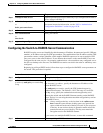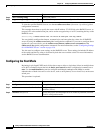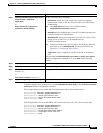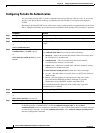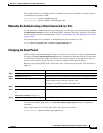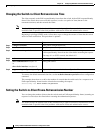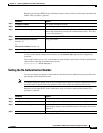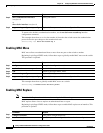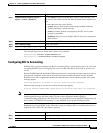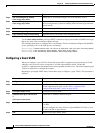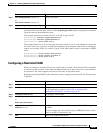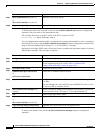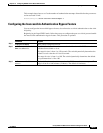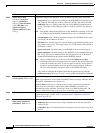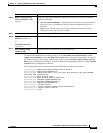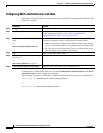
10-53
Catalyst 2960 and 2960-S Switch Software Configuration Guide
OL-8603-09
Chapter 10 Configuring IEEE 802.1x Port-Based Authentication
Configuring 802.1x Authentication
This example shows how to enable MAC replace on an interface:
Switch(config)# interface gigabitethernet2/0/2
Switch(config-if)# authentication violation replace
Configuring 802.1x Accounting
Enabling AAA system accounting with 802.1x accounting allows system reload events to be sent to the
accounting RADIUS server for logging. The server can then infer that all active 802.1x sessions are
closed.
Because RADIUS uses the unreliable UDP transport protocol, accounting messages might be lost due to
poor network conditions. If the switch does not receive the accounting response message from the
RADIUS server after a configurable number of retransmissions of an accounting request, this system
message appears:
Accounting message %s for session %s failed to receive Accounting Response.
When the stop message is not sent successfully, this message appears:
00:09:55: %RADIUS-4-RADIUS_DEAD: RADIUS server 172.20.246.201:1645,1646 is not responding.
Note You must configure the RADIUS server to perform accounting tasks, such as logging start, stop, and
interim-update messages and time stamps. To turn on these functions, enable logging of
“Update/Watchdog packets from this AAA client” in your RADIUS server Network Configuration tab.
Next, enable “CVS RADIUS Accounting” in your RADIUS server System Configuration tab.
Beginning in privileged EXEC mode, follow these steps to configure 802.1x accounting after AAA is
enabled on your switch. This procedure is optional.
Step 3
authentication violation {protect |
replace | restrict | shutdown}
Use the replace keyword to enable MAC replace on the interface. The
port removes the current session and initiates authentication with the new
host.
The other keywords have these effects:
• protect: the port drops packets with unexpected MAC addresses
without generating a system message.
• restrict: violating packets are dropped by the CPU and a system
message is generated.
• shutdown: the port is error disabled when it receives an unexpected
MAC address.
Step 4
end Return to privileged EXEc mode.
Step 5
show running-config Verify your entries.
Step 6
copy running-config startup-config (Optional) Saves your entries in the configuration file.
Command Purpose
Command Purpose
Step 1
configure terminal Enter global configuration mode.
Step 2
interface interface-id Specify the port to be configured, and enter interface configuration mode.



